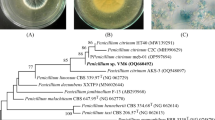Abstract
The metabolites of endophytic fungus Penicillium sp. from the leaf of Hopea hainanensis were reported for the first time. By bioassay-guided fractionation, the EtOAc extract of a solid-matrix steady culture of this fungus afforded six compounds, which were identified through a combination of spectral and chemical methods (IR, MS, 1H- and 13C-NMR) to be monomethylsulochrin (1), rhizoctonic acid (2), asperfumoid (3), physcion (4), 7,8-dimethyl-iso-alloxazine (5) and 3,5-dichloro-p-anisic acid (6). Compounds 2, 3 and 6 were obtained from Penicillium sp. for the first time. All of the six isolates were subjected to in vitro bioactive assays including antifungal action against three human pathogenic fungi Candida albicans, Trichophyton rubrum and Aspergillus niger and cytotoxic activity against the human nasopharyngeal epidermoid tumor KB cell line and human liver cancer HepG2 cell line. As a result, compounds 2–4 and 6 inhibited the growth of C. albicans with MICs of 40.0, 20.0, 50.0 and 15.0 μg/ml, respectively and the compound 6 showed growth inhibition against A. niger with MICs of 40.0 μg/ml. In addition, compounds 1–3 and 6 exhibited cytotoxic activity against KB cell line with IC50 value of 30.0, 20.0, 20.0, 5.0 μg/ml, respectively and against HepG2 cell line with IC50 value of 30.0, 25.0, 15.0, 10.0 μg/ml, respectively.

Similar content being viewed by others
References
Agarwal SK, Singh SS, Verma S, Kumar S (2000) Antifungal activity of anthraquinone derivatives from Rheum emodi. J Ethnopharmacol 72:43–46
Bauer AW, Kirby WM, Sherris JC, Turck M (1966) Antibiotic susceptibility testing by a standardized Single disk method. Am J Clin Pathol 45:493–496
Bills GF (1996) Isolation and analysis of endophytic fungal communities from woody plants. In: Redlin SC, Carris LM (eds) Endophytic fungi in grasses and woody plants. Systematics, ecology and evolution. St. Paul, MN, USA: APS Press, ISBN: 0-89054-213-9, pp 31–65
Curtis RF, Harries PC, Levi JD, Phillips DM (1966) The biosynthesis of phenols. Part X. Mutation and radioactive tracer studies relating to the biosynthesis of sulochrin. J Chem Soc C 2:168–174
Ge HM, Song YC, Shan CY, Ye YH, Tan, RX (2005) New and cytotoxic anthraquinones from Pleospora sp. IFB-E006, an endophytic fungus in Imperata cylindrical. Planta Medica 71:1063–1065
Grande HJ, Robert G, Willem JH et al (1977a) An 1H-NMR spectroscopic study of alloxazines and iso alloxazine [J]. Helev Chim Acta 60(2):348
Grande HJ, Robert G, Willem JH et al (1977b) 13C-NMR study on iso alloxazine and alloxazines derivatives [J]. Helev Chim Acta 60(2):367
Henk JS, Frank JMV, Jim AF, Joannes BPAW (1996) Novel chlorometabolites produced by Bjerkandera species. Plant Chem 42(6):1699–1701
Inamori Y, Kato Y, Kubo M, Kamiki T, Takemoto T (1983) Studies on metabolities produced by Aspergillus terreus var. aureus. I. Chemical structures and antimicrobial activities of metabolites isolated from culture broth. Chem Pharmacol Bull 31:4543–4548
Kiriyama N, Nitta K, Sakaguchi Y, Taguchi Y, Yamamoto Y (1977) Studies on the metabolites of the strain IFO 8835. Chem Pharmacol Bull 25:2593–2601
Kuo YC, Sun CM, Ou JC, Tsai WJ (1997) Atumor cell growth inhibitor from Polygonum hypoleucum Ohwi. Life Sci. Including Pharmacol Lett 61:2335–2344
Liu JY, Song YC, Zhang Z, Wang L, Guo ZJ, Tan RX (2004) Aspergillus fumigatus, CY018, an endophytic fungus in Cynodon dactylon as a versatile producer of new and bioactive metabolites. J Biotechnol 114:279–287
Lu XZ, Xu WH, Naoki H (1992) Anthraquinones from Salvia przewalskii. Phytochemistry 31:708–709
Ma YM, Li Y, Liu JY, Song YC, Tan RX (2004) Anti-Helicobacter pylori metabolites from Rhizoctonia sp. Cy064, an endophytic fungus in Cynodon dactylon. Fitoterapia 75:451–456
Manfred S, Christophe H, Elena M, Rosario S (2006) Proton mobility in 2-substituted 1,3-dichlorobenzenes: “ortho” or “meta” Metalation? Eur J Org Chem 19:4398–4404
Mahmoodian A, Stickings CE (1964) Studies in the biochemistry of micro-organisms. J Biochem 92:369–378
Ohashi H, Ueno A, Nakao T, Ito J, Kimura K, Ishikawa M, Kawai H, Iijima H, Osawa T (1999) Effects of ortho-substituent groups of sulochrin on inhibitory activity to eosinophil degranulation. Bioorg Chem Lett 9:945–948
Shu RG, Wang FW, Yang YM, Liu YX, Tan RX (2004) Antibacterial and xanthine oxidase inhibitory cerebrosides from Fusarium sp. IFB-121, an Endophytic Fungus in Quercus variabilis. Lipid 39:667–673
Silk PJ, Aubry C, Lonergan GC, Macaulay JB (2001) Chlorometabolite production by the ecologically important white rot fungus Bjerkandera adusta. Can Chemosphere 44(7):1603–1616
Tan RX, Zou WX (2001) Endophytes: a rich source of functional metabolites. Nat Prod Rep 18:448–459
Turner WB (1965) The production of trypacidin and monomethylsulochrin by Aspergillus fumigatus. J Chem Soc 90:6658–6660
Wagenaar MM, Corwin J, Strobel G, Clardy J (2000) Three new cytochalasins produced by an endophytic fungus in the genus Rhinocladiella. J Nat Prod 63:1692–1695
Wang CJ, Delcros JG, Biggerstaff J, Phanstiel O (2003) Synthesis and biological evaluation of N1-(Anthracen-9-ylmethyl) triamines as molecular recognition elements for the polyamine transporter. J Med Chem 46:2663–2671
Wang FW, Jiao RH, Cheng AB, Song YC (2007) Antimicrobial potentials of endophytic fungi residing in Quercus variabilis and brefeldin A obtained from Cladosporium sp. World J Microbiol Biotechnol 23:79–83
Wang FW, Ye YH, Chen JR, Wang XT, Zhu HL, Song YC, Tan RX (2006) Neoplaether, a new cytotoxic and antifungal endophyte metabolite from Neoplaconema napellum IFB-E016. FEMS Microbiol Lett 261:218–223
Ye YH, Zhu HL, Song YC, Liu JY, Tan RX (2005) Structural revision of Aspernigrin A, reisolated from Cladosporium herbarum IFB-E002. J Nat Prod 68:1106–1108
Acknowledgements
The work was co-supported by NSFC (20432030) and by QDNSF (06-2-2-15-jch).
Author information
Authors and Affiliations
Corresponding author
Rights and permissions
About this article
Cite this article
Wang, F.W., Hou, Z.M., Wang, C.R. et al. Bioactive metabolites from Penicillium sp., an endophytic fungus residing in Hopea hainanensis . World J Microbiol Biotechnol 24, 2143–2147 (2008). https://doi.org/10.1007/s11274-008-9720-8
Received:
Accepted:
Published:
Issue Date:
DOI: https://doi.org/10.1007/s11274-008-9720-8




